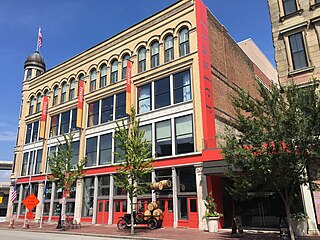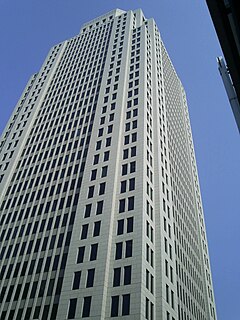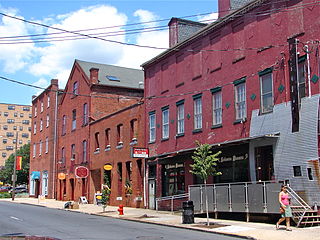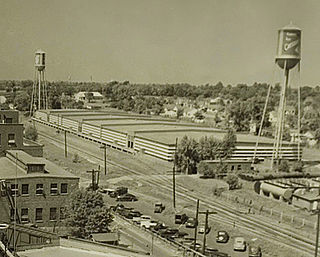
Caldwell County is a county located in the U.S. state of Kentucky. As of the 2010 census, the population was 12,984. Its county seat is Princeton. The county was formed in 1809 from Livingston County, Kentucky and named for John Caldwell, who participated in the George Rogers Clark Indian Campaign of 1786 and was the second lieutenant governor of Kentucky. Caldwell was a prohibition or dry county until 2013, when the citizens voted to lift the ban.
The American Tobacco Company was a tobacco company founded in 1890 by J. B. Duke through a merger between a number of U.S. tobacco manufacturers including Allen and Ginter and Goodwin & Company. The company was one of the original 12 members of the Dow Jones Industrial Average in 1896. The American Tobacco Company dominated the industry by acquiring the Lucky Strike Company and over 200 other rival firms. Antitrust action begun in 1907 broke the company into several major companies in 1911.

James Buchanan Duke was an American tobacco and electric power industrialist best known for the introduction of modern cigarette manufacture and marketing, and his involvement with Duke University.
The Black Patch Tobacco Wars were a period of civil unrest and violence in the western counties of the U.S. states of Kentucky and Tennessee at the turn of the 20th century, circa 1904-1909. The so-called "Black Patch" consists of about 30 counties in southwestern Kentucky and northwestern Tennessee; during that period this area was the leading worldwide supplier of Dark Fired Tobacco. It was so named for the wood smoke and fire-curing process which it undergoes after harvest. This type of tobacco is used primarily in snuff, chewing and pipe tobacco.
Liggett Group, formerly known as Liggett & Myers Tobacco Company, is the fourth largest tobacco company in the United States. Its headquarters are located in Durham, North Carolina, though its manufacturing facility is 30 miles to the west in Mebane, North Carolina. The company is a subsidiary of holding company Vector Group.

The Louisville Slugger Museum & Factory, is a museum and factory tour attraction located in Louisville, Kentucky's "Museum Row", part of the West Main District of downtown. The museum showcases the story of Louisville Slugger baseball bats in baseball and in American history. The museum also creates temporary exhibits with more of a pop culture focus, including collaborations with the Norman Rockwell Museum, the Charles M. Schulz Museum and Research Center, Coca-Cola, LEGO artists Sean Kenney and Jason Burik, Topps Trading Cards, The Children's Museum of Indianapolis, and Ripley's Believe It or Not!.

The Frazier History Museum, previously known as the Frazier Historical Arms Museum and the Frazier International History Museum, is a history museum located on Museum Row in the West Main District of downtown Louisville, Kentucky. An affiliate of the Smithsonian Institution, the Frazier documents and reinterprets stories from history using artifacts, gallery talks, and live interpretations that are written and performed in costume by a staff of teaching artists.

Downtown Louisville is the largest central business district in the Commonwealth of Kentucky and the urban hub of the Louisville, Kentucky Metropolitan Area. Its boundaries are the Ohio River to the north, Hancock Street to the east, York and Jacob Streets to the south, and 9th Street to the west. As of 2015, the population of Downtown Louisville was 4,700, although this does not include directly surrounding areas such as Old Louisville, Butchertown, NuLu, and Phoenix Hill.
Irish Hill is a neighborhood east of downtown Louisville, Kentucky USA. It is bounded by Baxter Avenue to the west, Lexington Road to the north, the middle fork of Beargrass Creek and I-64 to the east. Cave Hill Cemetery is located directly south of Irish Hill. It is in the inner Highlands area of Louisville.
The economy of Lexington, Kentucky was shaped by its considerable distance from any major navigable rivers. As a landlocked city, it did not develop the heavy industry that often developed in cities like Cincinnati or Pittsburgh. To counter this, Lexington put forth an effort to stay at the forefront of modern technology in an effort to attract a diverse light industrial and commercial base. For instance, the city was the first in Kentucky to have street lights, one of the first with a police force, and strict regulations on agriculture within the city. Lexington was also proud to boast its urban sewer system and its network of sidewalks, all of this by the early 1880s. Other infrastructure improvements were to come in the latter 1880s, including telephone lines, street railways, and a new ice factory. These improvements helped solidify Lexington's position as the "agricultural and manufacturing keystone" for the region.

The Globe Tobacco Building is a manufacturing building located at 407 East Fort Street in Downtown Detroit, Michigan. It is the oldest tobacco manufactory extant in Detroit, and is listed by the National Register of Historic Places.

The Brown Tobacco Warehouse is a historic warehouse building located at 1019-1025 West Main Street in Louisville, Kentucky. The two-story brick structure was built in 1892. It was first occupied by John W. Brown & Brothers Tobacco Company.
The Seagram's Distillery is a historic building complex in Louisville, Kentucky, on Seventh Street Road. It was originally constructed between 1933 and 1936 for the production of bourbon whiskey by Distillers Corporation Limited, who acquired Joseph E. Seagram & Sons in 1928. The Seagram company has since ceased operation, and its assets were acquired by other companies, notably The Coca-Cola Company, Diageo, and Pernod Ricard.

Oakdale Memorial Gardens, formerly Oakdale Cemetery, is located in east-central Davenport, Iowa, United States. It contains a section for the burial of pets called the Love of Animals Petland. In 2015, the cemetery was listed as an historic district on the National Register of Historic Places, and as a local landmark on the Davenport Register of Historic Properties. It is also listed on the Network to Freedom, a National Park Service registry for sites associated with the Underground Railroad.

Teller Brothers–Reed Tobacco Historic District is a historic cigar factory and tobacco warehouse complex and national historic district located at Lancaster, Lancaster County, Pennsylvania. It includes five contributing buildings, built between about 1865 and 1900. They are the John F. Reed & Co. Cigar Factory, J.R. Bitner Tobacco Warehouse, Lancaster Paint Works, and two warehouses associated with the Teller Brothers, built about 1877 and 1885. All five buildings are brick buildings over stone foundations, 2 1/2- to 4 stories tall, and used for the processing and storage of cigar leaf tobacco.
Luckett & Farley is an architecture, engineering, and interior design firm based in Louisville, Kentucky. It was founded in 1853, making it the oldest continually operating architecture firm in the United States that is not a wholly owned subsidiary. The firm began under the name Rogers, Whitestone & Co., Architects, changing its name to Henry Whitestone in 1857, to D.X. Murphy & Brother in 1890, and to Luckett & Farley in 1962. The company is 100% employee-owned as of January 1, 2012 and concentrates on automotive, industrial, federal government, higher education, health and wellness, and corporate/commercial markets. There are more LEED professionals at Luckett & Farley than any other company in Kentucky with 50, as of December 2012.
The following is a timeline of the history of the city of Louisville, Kentucky, USA.
Charles Hermany (1830–1908) was an engineer and architect. He assisted Theodore Scowden in designing the Louisville Water Works buildings. He designed the Crescent Hill Water Plant. Hermany was the chief engineer and superintendent of the Louisville Water Company for more than 25 years and designed water systems for Bowling Green, Kentucky and Frankfort, Kentucky. His map of a park system for the Salmagundi Club is said to have inspired Frederick Law Olmsted's work.

The Liggett and Myers Harpring Tobacco Storage Warehouse is a building located in Lexington, Kentucky. The building is significant for its association with the burley tobacco industry in Lexington, Kentucky between 1930 and 1980 and is currently listed on the National Register of Historic Places listings in Fayette County, Kentucky.

George L. Trayser was a German-born American piano maker. He emigrated to the United States in 1849, and made pianos in Indianapolis and Richmond, Indiana. His pianos—due to their high quality and rich, resonant tone and responsive action—had a reputation as instruments suitable for school and concert work.











